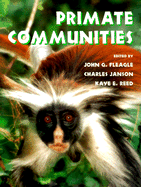Book contents
- Frontmatter
- Contents
- List of contributors
- Preface
- 1 African primate communities: Determinants of structure and threats to survival
- 2 Biomass and use of resources in south and south-east Asian primate communities
- 3 Species coexistence, distribution, and environmental determinants of neotropical primate richness: A community-level zoogeographic analysis
- 4 Primate communities: Madagascar
- 5 Primate diversity
- 6 Phylogenetic and temporal perspectives on primate ecology
- 7 Population density of primates in communities: Differences in community structure
- 8 Body mass, competition and the structure of primate communities
- 9 Convergence and divergence in primate social systems
- 10 Of mice and monkeys: Primates as predictors of mammal community richness
- 11 Comparing communities
- 12 Large-scale patterns of species richness and species range size in anthropoid primates
- 13 The recent evolutionary past of primate communities: Likely environmental impacts during the past three millennia
- 14 Resources and primate community structure
- 15 Effects of subsistence hunting and forest types on the structure of Amazonian primate communities
- 16 Spatial and temporal scales in primate community structure
- 17 Primate communities in Africa: The consequences of long-term evolution or the artifact of recent hunting?
- 18 The future of primate communities: A reflection of the present?
- 19 Concluding remarks
- Systematic index
- Subject index
2 - Biomass and use of resources in south and south-east Asian primate communities
Published online by Cambridge University Press: 21 August 2009
- Frontmatter
- Contents
- List of contributors
- Preface
- 1 African primate communities: Determinants of structure and threats to survival
- 2 Biomass and use of resources in south and south-east Asian primate communities
- 3 Species coexistence, distribution, and environmental determinants of neotropical primate richness: A community-level zoogeographic analysis
- 4 Primate communities: Madagascar
- 5 Primate diversity
- 6 Phylogenetic and temporal perspectives on primate ecology
- 7 Population density of primates in communities: Differences in community structure
- 8 Body mass, competition and the structure of primate communities
- 9 Convergence and divergence in primate social systems
- 10 Of mice and monkeys: Primates as predictors of mammal community richness
- 11 Comparing communities
- 12 Large-scale patterns of species richness and species range size in anthropoid primates
- 13 The recent evolutionary past of primate communities: Likely environmental impacts during the past three millennia
- 14 Resources and primate community structure
- 15 Effects of subsistence hunting and forest types on the structure of Amazonian primate communities
- 16 Spatial and temporal scales in primate community structure
- 17 Primate communities in Africa: The consequences of long-term evolution or the artifact of recent hunting?
- 18 The future of primate communities: A reflection of the present?
- 19 Concluding remarks
- Systematic index
- Subject index
Summary
INTRODUCTION
Primate habitats in south-east Asia span the two main forest formations of this part of the Oriental region – the deciduous monsoon rainforests of mainland Asia north of the isthmus of Kra and the evergreen rain forests of the “islands” of the Sunda Shelf (Whitmore, 1975). The evergreen rainforests of the Sunda Shelf comprise the main primate habitat, but significant numbers of taxa and individuals occur in the more seasonal forests of mainland Asia, mostly concentrated in pockets of evergreen forest surviving in the moister areas under maritime influence, e.g., Indo-China, Thailand, south India and Sri Lanka, Burma, and Bangladesh (Table 2.1). Intermittent volcanic activity over the last 100 million years has thrown up several arcs of mountains, creating the Sunda Shelf only about 12 million years ago; they run mainly from the north-west to the south-east, with the largest down the west of Sumatra.
The Sunda Shelf owes its uniquely rich fauna (and flora) to an admixture of immigrants. First came the Siva-Malayan fauna from the Indian subcontinent, nearly two million years ago during the Villafranchian. Then, nearly one million years ago, the Sino-Malayan fauna came from southern China, while the spread of tropical rainforest and/or the spread of the cold influence of the Himalayas blocked the Indian route.
It is important to note that during periods of lowest sea level, the center of the Shelf dried out. The key rainforest relicts, into which primates and other forest animals retreated and out of which they spread when sea level rose, were in eastern Indo-China and southern China, north-eastern Borneo, west Java, north Sumatra and southern Burma, as well as the Mentawai Islands.
- Type
- Chapter
- Information
- Primate Communities , pp. 38 - 54Publisher: Cambridge University PressPrint publication year: 1999
- 18
- Cited by

